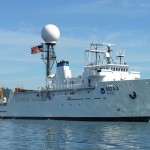 Combining the scientific resources of the National Oceanic and Atmospheric Administration (NOAA) with Google’s software expertise is bound to change the way we see the world.
Combining the scientific resources of the National Oceanic and Atmospheric Administration (NOAA) with Google’s software expertise is bound to change the way we see the world.
According to Richard Spinrad, NOAA’s assistant administrator for research, a recent working agreement between NOAA and Google will be open to exploration in many different areas—but an advance in data visualization promises to be one of the most exciting. “Right now on Google Earth you can pull up data on a flat screen and see some really interesting things,” Spinrad explains to Government Computer News. “Imagine doing that on a sphere. That’s powerful stuff.”
NOAA’s Science on a Sphere program already creates spherical displays of scientific data, using a computer-driven multi-projector system plus a suspended, ball-shaped screen nearly six feet across. And numerous data sets—illustrating weather on Mars, plate tectonics, ocean currents and much more–have already been developed for the SOS system, which is installed in museums, science centers, schools, and research facilities around the country. But one of the new Google-NOAA initiatives is expected to be integration of SOS technology with the Keyhole Markup Language (KHL) used in Google Earth. That would create a rich source of new data sets for SOS, as well as offering Google a new way to display data.
Another goal is likely to be display of video and data from NOAA’s Okeanos Explorer, a state-of-the-art science vessel designed to engage the public through live feed of its voyages and discoveries. The ship is equipped for near-real-time transmission—but handling such large data flows will present plenty of challenges, so the NOAA-Google connection could be one key to realizing the potential of this ambitious program.
Some other possible outcomes of the alliance (such as putting data from the Integrated Ocean Observing System online and providing interactive access to marine zoning information) are a little more mundane. But they could significantly increase public access to the huge amount of scientific information gathered by one of the government’s most active agencies.
NOAA and Google have cooperated on projects in the past—notably, the development of Google Ocean. But it’s not easy to bring two powerhouse players like these into a more formal alignment. NOAA’s Alan Leonardi spent a five-month fellowship at Google, laying the groundwork for closer ties—and demonstrating the potential of linking big science with high tech.





